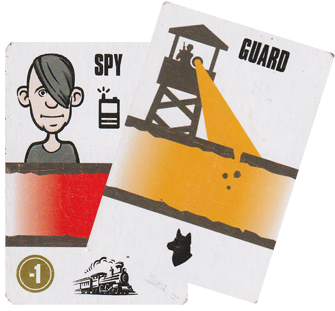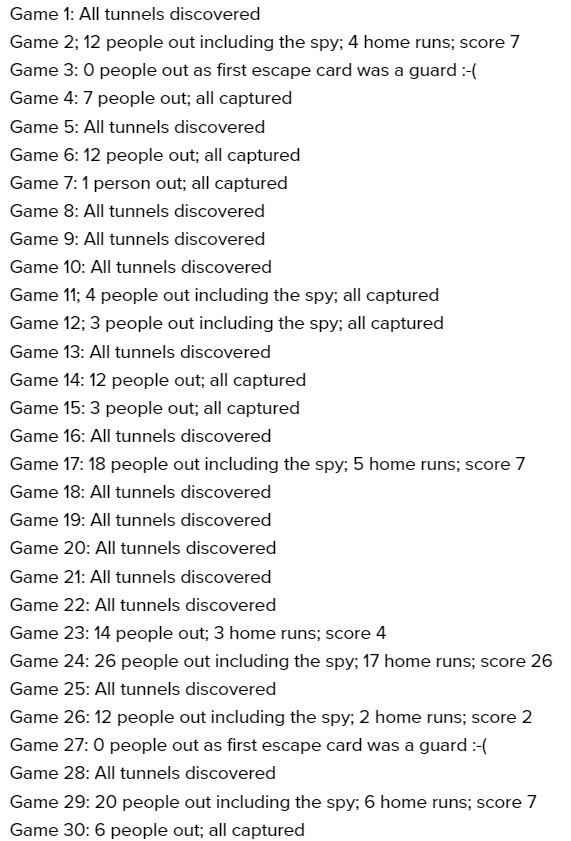
During the Second World War, several escapes from Prisoner of War camps in Germany were achieved by the extremely hazardous creation of tunnels below the camps. Tunnels dug below the noses of the ever-alert guards.
The Great Escape is based on one such venture. It’s a relative newcomer to the solo game scene, devised by John Grills, and appearing in 2021.
It’s not at all easy to get back home. John reminds us that only seventy six men actually got out through tunnel “Harry”, of whom just three made it home. So, there are very high chances that there will be no escapes at all, or very few.
A zero score is highly likely …. low scores are not a sign that you’re stupid, but that the chances are slim. Indeed, the designer told one first-time player that a score of six was pretty good.

The player simply (?) goes through a three stage process, using the characterful cards – such as Spud and Porky.
Characters-cards’ upper parts show what each of the forty four escapees and the single spy will have with them if they get out of the camp, when they move to the second stage of escape.
The cards’ central section shows what each character will do within the tunnel. They may dig a simple section, or put in some props, or install a ventilation shaft – or bring about a collapse.
Every card’s bottom section shows what actions the guards will get up to in stage three of the escape effort.
It also shows the score, if that escapee makes it home.
Not all are digging escapees of course.
There’s a spy, and three guards.

Stage 1 – can they get a tunnel built?
The first stage is tunnel digging, using the central section of the cards. Digging is awash with dangers from guards and a sneaky spy.
If either appears, a tunnel is lost! The player chooses which it’s to be – it’s lost totally: removed.
If there’s a collapse, that card must be covered by a non-collapse card before the tunnel can go forward. A collapse can be placed where a ventilation shaft or support props are due to appear, and they must overlay it later, permitting the tunnel to go on.
There must be support props every third card from the tunnel’s start or from previous props … they can be placed more close together than that, but no less.
And there must be ventilation shafts every fifth card, in the same fashion.
If a tunnel reaches ten cards in length, it’s complete. No more cards are laid, and the tunnellers move to stage 2 of the great escape.
► How do we do the digging?
Cards are shuffled, and three are placed to start three separate tunnels – Tom, Dick, and Harry.
Cards are taken from the deck and added to the tunnels as the player chooses, following the rules about props, ventilation, and collapses.
Of course, they cannot be moved once placed.
Cards that cannot be used are put at the bottom of the draw-pack.
Digging continues thus until …
EITHER a tunnel’s found by a guard or revealed by a spy (when their cards appear, accompanied by much silent swearing). That tunnel’s characters are removed from play completely, along with the guard or spy.
OR a tunnel achieves a total length of ten sections – at which point stage 1 of the great escape has been successful.
Well done chaps ❗
Stage 2 – can they sneak away from the guards?
If any tunnel gets completed, and if anybody gets out, we move to stage two.
Understandably, the guards are now on full alert and are actively seeking escapees.
► How do they go about it?
The escapees who’ll try to survive stage 2 are all those still in hand (the draw pack) when the tunnel’s completed. Guards and perhaps the spy will be lurking in their midst of course.
(The pack isn’t shuffled unless the player chooses to do so.)
Character by character, those who tunnelled out break into the open. They’re arrayed face up.
If the spy appears, he’s laid down in the same way.
This continues until such time as a guard turns up! At that point, all who’ve not yet been drawn have not made it beyond the perimeter – they are captured : put aside.
Their valiant involvement is ended.
Good try chaps. We’re pround of you ❗
Stage 3 – can they stay at large?
So, some may have tunnelled out (stage1), and some of those may have escaped early capture (stage 2). The escape items they have with them are displayed alongside their mugshots, at the top (described on rule card 6). At the bottom there’s a medal, which shows how many welcome home scores they’ll get if they get home.
How many will make it past the network of highly organised surveillance that the enemy has set up?
How many will get home?
Fine-mesh fishing nets are dropped by the enemy. Escapees must fight difficult odds to avoid being detected.
► How does the enemy make it’s final push to capture the escapees?
After laying the array of escapees, right up to the time that a guard came on the scene (who can be put aside), there hopefully will be some cards left in the draw-pack.
These are revealed one by one, and the guards take the actions that are shown at the bottom each card. These actions are described on rules cards 8 and 9.
For example, if the determined enemy is laying barriers of barbed wire all over the place, it doesn’t pay to be without wire cutters. Because he’s got none, Porky (see his picture, above) would be for the chop (as would Flint and Slim)!
Spud, however, hasn’t had his chips – he’s got cutters, and stays on the loose!
Similarly, if the enemy is checking all train riders, they’re likely to spot faked tickets, so characters who are carrying one will get caught. Sadly, Slim’s brought back in!
This goes on until either there are no escapees still at large, or the pack runs out.
If all escapees are captured, this escape effort has totally failed.
If the pack runs out, there can be no more searching and surveillance. Some escapees may have made it back to Blighty.
In that case, the score is the value of the medals pinned on proud chests – with the spy always counting as minus 1, if he’s still around.
Welcome home, heroes. ❗
As the record from one contributor to chat at BoardGameGeek shows, zero scores are very common indeed.
This well confirms John Grills’ telling us that escape was far, far from easy – fraught with endless dangers.

Making it a little easier
► John Grills suggests shuffling any POW’s from the successful tunnel and any part completed tunnels back into the deck for stage 2 of the escape effort.
In theory, John tells us, these they might still have been free to escape – they weren’t definitely captured. Only those in a discovered tunnel would definitely be captured and sent to the cooler.
► For an even easier game, give the same undiscovered tunnellers some special treatment for all their hard work. Simply add them to the top of the deck before stage 2, and don’t shuffle it. This guarantees that at least ten will get out before a guard shows up.
RECON expansion here
► Escaping is an excruciatingly precarious affair.
► The chances of getting home are extremely slim.
► But do keep trying!

- 48 small, good-feel cards: play anywhere
- comes with a set of small explanation cards
- a lot of luck is involved … as in all solitaire games … some bad luck too
- don’t let the guards get you down 🙂
► dare to dig in?

